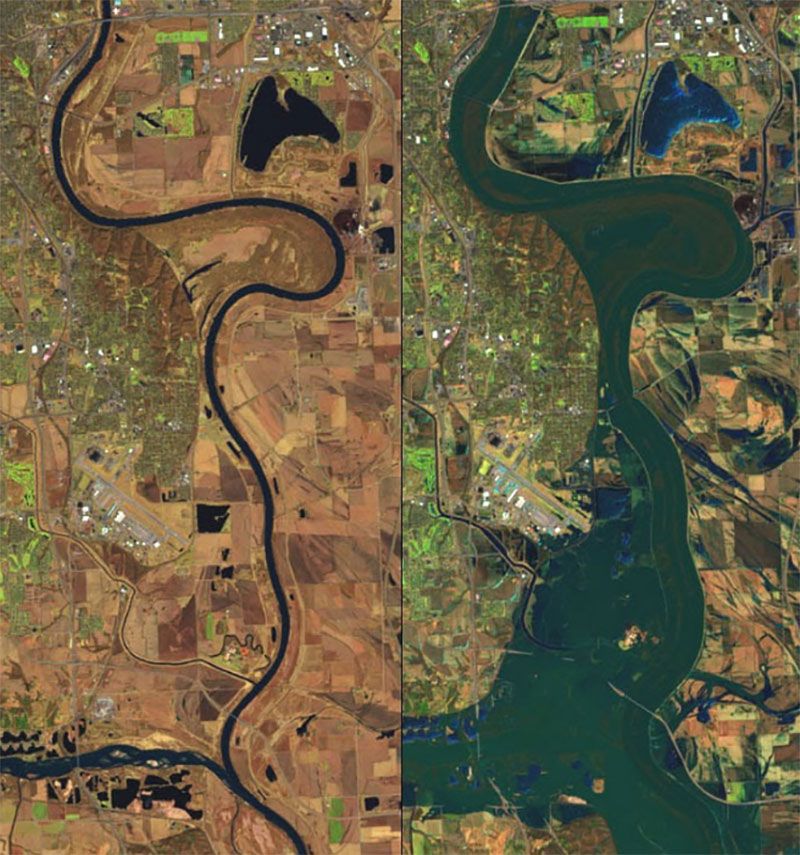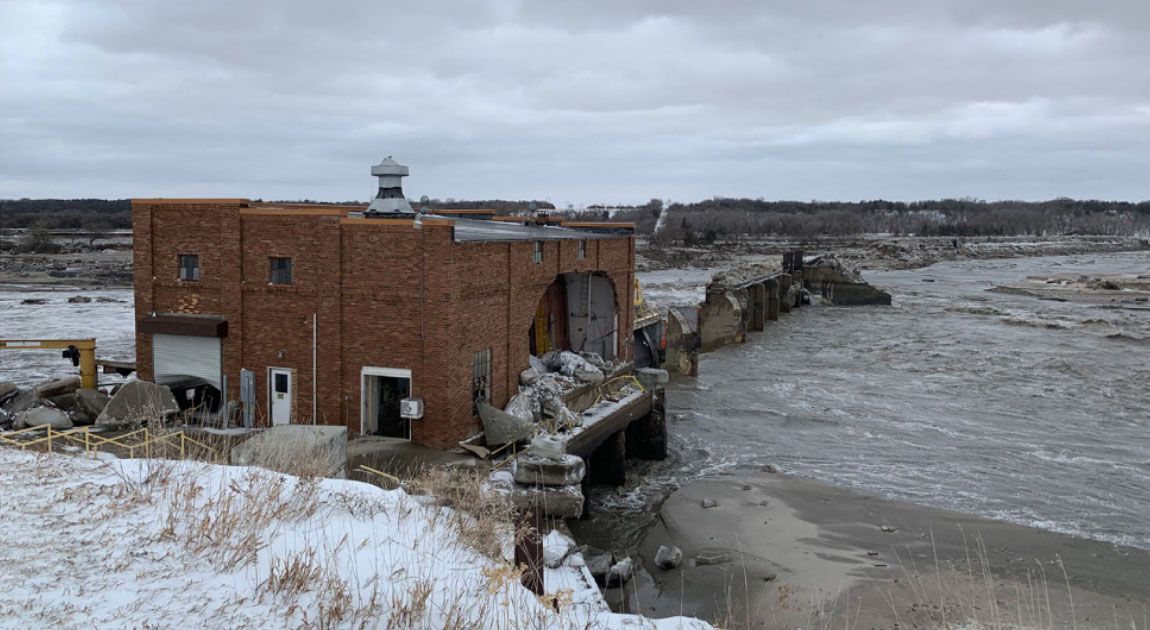2020 CASE STUDY 2
The 2019 Floods in the Central U.S.
Lessons for Improving Health, Health Equity, and Resiliency
In spring 2019, the Midwest region endured historic flooding that caused widespread damage to millions of acres of farmland, killing livestock, inundating cities, and destroying infrastructure.CS_52
The Missouri River and North Central Flood resulted in over $10.9 billion of economic loss in the region, making it the costliest inland flood event in U.S. history.CS_52 Yet, this is just the beginning, as climate change continues to accelerate extreme precipitation, increasing the likelihood of severe events previously thought of as “once in 100 year floods.”CS_53,CS_54
This 2019 disaster exhibited the same health harms and healthcare system disruptions seen in previous flooding events, and vulnerable populations – notably tribal and Indigenous communities – were once again disproportionately impacted. Thus, there is an enormous need for policy interventions to minimize health harms, improve health equity, and ensure community resilience as the frequency of these weather events increases.
FIGURE 1
Before-and-after images of catastrophic flooding in Nebraska. Left image taken March 20, 2018. Right image taken March 16, 2019.

Source: NASA Goddard Space Flight Center, with permission
The role of climate change, widespread devastation, and compounding inequities
The Missouri River and North Central Flood were the result of a powerful storm that occurred near the end of the wettest 12-month period on record in the U.S. (May 2018 – May 2019).CS_55, CS_56The storm struck numerous states, specifically Nebraska (see Figure 1), Iowa, Missouri, South Dakota, North Dakota, Minnesota, Wisconsin, and Michigan. Two additional severe flooding events occurred in 2019 in states further south, involving the Mississippi and Arkansas Rivers.
This flood event exhibits two key phenomena that have been observed over the last 50 years as a result of climate change: annual rainfall rates and extreme precipitation have increased across the country.CS_57 The greatest increases have been seen in the Midwest and Northeast, and these trends are expected to continue over the next century. Future climate projections also indicate that winter precipitation will increase over this region,CS_57 further increasing the likelihood of more frequent and more severe floods. For example, by mid-century the intensity of extreme precipitation events could increase by 40% across southern Wisconsin.CS_58 While it is too early to have detection and attribution studies for these floods, climate change has been linked to previous extreme precipitation and flood events.CS_59, CS_60
Hundreds of people were displaced from their homes and millions of acres of agricultural land were inundated with floodwaters, killing thousands of livestock and preventing crop planting.CS_52, CS_61, CS_62 Federal Emergency Management Agency (FEMA) disaster declarations were made throughout the region, allowing individuals to apply for financial and housing assistance, though remaining at the same housing site continues to place them at risk of future flood events.
In Nebraska alone, 104 cities, 81 counties and 5 tribal nations received state or federal disaster declarations. FEMA approved over 3,000 individual assistance applications in Nebraska, with more than $27 million approved in FEMA Individual and Household Program dollars. In addition to personal property, infrastructure was heavily affected, with multiple bridges, dams, levees, and roads sustaining major damage (see Figure 2).CS_52
FIGURE 2
Destruction of Spencer Dam during Missouri River and North Central Floods.CS_63

- Oglala Sioux Tribe, Cheyenne River Sioux Tribe of the Cheyenne River Reservation, Standing Rock Sioux Tribe (North Dakota and South Dakota), Yankton Sioux Tribe of South Dakota, Lower Brule Sioux Tribe of the Lower Brule Reservation, Crow Creek Sioux Tribe of Crow Creek Reservation, Sisseton-Wahpeton Oyate of the Lake Traverse Reservation, Rosebud Sioux Tribe of the Rosebud Sioux Indian Reservation, Santee Sioux Nation, Omaha Tribe of Nebraska, Winnebago Tribe of Nebraska, Ponca Tribe of Nebraska, Sac & Fox Nation of Missouri (Kansas and Nebraska), Iowa Tribe of Kansas and Nebraska, and Sac & Fox Tribe of the Mississippi in Iowa.
Source: Nebraska Department of Natural Resources, with permission.
As with other climate-related disasters, the 2019 floods had devastating effects on already vulnerable communities as numerous tribes and Indigenous peoples were impacted,° adding to centuries of historical trauma.CS_64, CS_65 Accounts of flooding on the Pine Ridge Reservation in South Dakota demonstrate the challenges that resource-limited communities face in coping with extreme weather events.CS_64 Delayed response by outside emergency services left tribal volunteers struggling to help residents stranded across large distances without access to supplies, drinking water, or medical care.66 Lack of equipment and limited transportation hampered evacuations.CS_67
Health harms and healthcare disruptions
There were three recorded deaths from drowning, but hidden health impacts were widespread and extended well beyond the immediate risks and injuries from floodwaters. In the aftermath, individuals in flooded areas were exposed to hazards like chemicals, electrical shocks, and debris.CS_68 Water, an essential foundation for health, was contaminated as towns’ wells and other drinking water sources were compromised. This put people, especially children, at increased risk for health harms like gastrointestinal illnesses.CS_69 Stranded residents relied on shipments of water from emergency services and volunteer organizations and the kindness of strangers (see Box 1).
BOX 1: “We just remember the trust and commitment to each other”
Linda Emanuel, a registered nurse and farmer living in the hard-hit rural area of North Bend in Nebraska, helped organize flood recovery efforts. She recalled wondering, “How are we going to handle this? How do we inform the people of all the hazards without scaring them?” In addition to her educational role, she administered a limited supply of tetanus shots, obtained and distributed hard-to-find water testing kits, and coordinated PPE usage. In the first days of the flooding, she hosted some 25 stranded individuals in her home. Reminiscing about how community members came together amidst the devastation, Emanuel remarked, “We just remember the trust and the commitment to each other and to our town. We are definitely a resilient city.”CS_70
Standing water remained in many small town for months, and a four-year old child at the Yankton Sioux reservation in South Dakota likely contracted Methicillin-resistant Staphylococcus aureus (MRSA) after playing in a pond.CS_71 The mold and allergens that developed in the aftermath of the floods exacerbated respiratory illness.CS_72 Flooding also backed up sewer systems into basements; clean up required personal protective equipment (PPE) to prevent the potential spread of infectious diseases. The significant financial burdens, notably the loss of property in the absence of adequate insurance, can contribute to serious mental and emotional distress in flood victims.CS_73, CS_74
Infrastructure disruptions, like flooded roads, meant that many individuals in rural areas were unable to access essential services including healthcare. In an interview with the New York Times, Ella Red Cloud-Yellow Horse, 59, from Pine Ridge Indian Reservation, recounts her own struggle to get to the hospital for a chemotherapy appointment.CS_64 After being stranded by flooding for days, she had contracted pneumonia, but she couldn’t be reached by an ambulance or tractor because her driveway was blocked by huge amounts of mud. She was forced to trudge through muddy flood waters for over an hour to get to the highway.
She told the Times, “I couldn’t breathe, but I knew I needed to get to the hospital.” Her story is an increasingly common occurrence as critical infrastructure is damaged by climate change-intensified extreme events. These infrastructure challenges are also often superimposed on top of the challenges of poverty and disproportionate rates of chronic diseases (see the Case Study). Multiple hospitals sustained damage and several long-term care facilities were forced to evacuate, with some closing permanently, as a result of the rising floodwaters,CS_75 likely exacerbating existing diseases.
A path towards a healthier, equitable, and more resilient future
As human-caused climate change increases the likelihood of precipitation events that can cause severe flooding disasters, public health systems must serve as a first line of defense against the resulting health harms. As such, the broader public health system needs to develop the capacity and capability to understand and address the health hazards associated with climate-related disasters. Often funds and resources for these efforts are focused on coastal communities; however, inland states face many climate-related hazards that are regularly overlooked. Building on or expanding programs similar to CDC’s Climate-Ready States and Cities Initiative will help communities in inland states prepare for future climate threats.CS_76
Additionally, public health officials, health systems, and climate scientists should collaborate to create robust early warning systems to help individuals and communities prepare for flood events. Education regarding the health impacts of flooding should not be limited to the communities affected, but it should also include policymakers and other stakeholders who can implement systemic changes to decrease and mitigate the effects of floods. Local knowledge offered by community members regarding water systems, weather patterns, and infrastructure will be essential for effective and context-specific adaptation. By implementing these changes and executing more inclusive flood emergency plans, communities will be better situated to face the flood events that are projected to increase in the years to come.